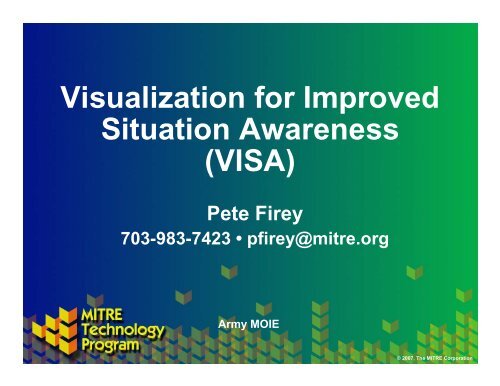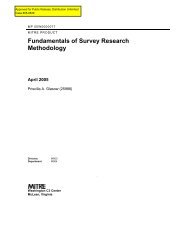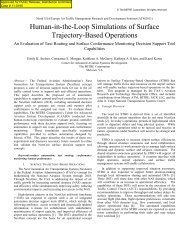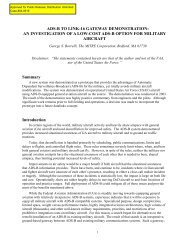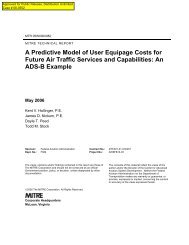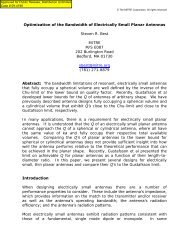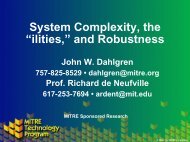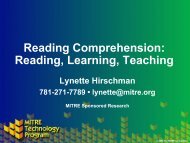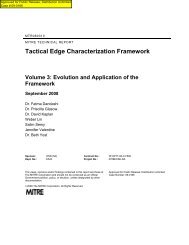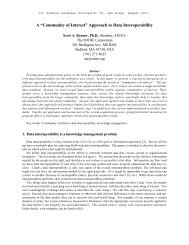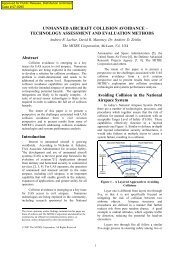Visualization for Improved Situational Awareness - Mitre
Visualization for Improved Situational Awareness - Mitre
Visualization for Improved Situational Awareness - Mitre
Create successful ePaper yourself
Turn your PDF publications into a flip-book with our unique Google optimized e-Paper software.
<strong>Visualization</strong> <strong>for</strong> <strong>Improved</strong><br />
Situation <strong>Awareness</strong><br />
(VISA)<br />
Pete Firey<br />
703-983-7423 • pfirey@mitre.org<br />
Army MOIE<br />
© 2007, The MITRE Corporation
Problem<br />
Warfighters see fragmented in<strong>for</strong>mation<br />
– Detected tracks and targets<br />
– And location of (some) ISR plat<strong>for</strong>ms<br />
But have NO comprehensive view<br />
(of the confidence and pedigree)<br />
– Lack of targets (wrongly) implies lack of threat<br />
– Lack of blue <strong>for</strong>ces or neutrals (wrongly) implies<br />
no collateral or fratricide<br />
– No ability to comprehend sensing acuity and<br />
currency<br />
Which leads to failures and casualties<br />
© 2007, The MITRE Corporation
Objective<br />
Scott,<br />
Replace “map” with<br />
this image so we can<br />
get public release<br />
Standard COP display<br />
VISA: Mapping the fog of<br />
war – showing what we<br />
know and what we don’t<br />
Rein<strong>for</strong>cement<br />
s<br />
Movement<br />
VISA: Knowing what’s<br />
happening next & where<br />
© 2007, The MITRE Corporation
Activities 1<br />
Develop designs to meet needs <strong>for</strong> analysis,<br />
collection management, and execution<br />
– Systems of composed services<br />
– Exposing models, applications, and systems as services;<br />
<strong>for</strong> example, line of sight, mobility, terrain concealment<br />
Create prototype <strong>for</strong> simulation or live feed<br />
assessment of operational or analytic capability<br />
– Representative sensors, plat<strong>for</strong>ms, and C2 data<br />
– Incorporate anticipated hot spots<br />
Extend visualization<br />
– Dynamic configurable presentation overlays<br />
– Presentation service to support 2D and 3D<br />
– Time controller (historical, current, planned)<br />
Assess per<strong>for</strong>mance and user feedback<br />
1 VISA completed initial concept and prototype development, data mining, and analysis in FY06<br />
© 2007, The MITRE Corporation
Highlight: VISA “Fog of War”<br />
Overview<br />
Operators define area of<br />
interest (AOI) & resolution<br />
– e.g., a 10 square kilometer AOI<br />
with 100 x 100 cells<br />
VISA generates a<br />
confidence grid<br />
– Incorporates C2, ISR, and<br />
mined data<br />
– For each cell, VISA<br />
Computes confidence<br />
Accounts <strong>for</strong> time decay<br />
VISA Presentation Service<br />
– Available <strong>for</strong> analysis,<br />
planning, or execution<br />
Cell<br />
Grid<br />
AOI<br />
© 2007, The MITRE Corporation
Highlight<br />
GIS Data Layers<br />
Target Class<br />
Terrain Mobility<br />
Weather<br />
VISA Data Services<br />
Sensor(s) Models<br />
LOS<br />
LOS<br />
Service<br />
Service<br />
Concealment<br />
OCOKA<br />
Service<br />
Model<br />
Service<br />
e.g., OCOKA<br />
Mobility<br />
NRMM Service<br />
Service<br />
e.g., NRMM<br />
Line of<br />
Sight<br />
(Occlusion)<br />
Terrain<br />
Concealment<br />
(Visibility)<br />
Target<br />
Mobility<br />
(Decay)<br />
VISA<br />
Sensor<br />
Service<br />
GRID<br />
Service<br />
Controller<br />
Cell Service<br />
Cell Service<br />
• Current<br />
• Current<br />
observations<br />
•<br />
observations<br />
Degrading<br />
•<br />
•Decaying<br />
Degrading<br />
•Decaying<br />
VISA VISA<br />
Presentation Publishing<br />
Service Services<br />
Controller<br />
Service<br />
Planned<br />
VISA<br />
Archive<br />
Service<br />
•Historical<br />
•Planned<br />
• Line Of Sight (LOS)<br />
• NATO Reference Mobility Model (NRMM)<br />
• Observation and Fields of Fire, Cover and Concealment, Obstacles, Key Terrain, Avenues of Approach (OCOKA)<br />
Google Earth<br />
C2PC<br />
…<br />
GOTS Java App<br />
Other<br />
Services<br />
© 2007, The MITRE Corporation
Demonstration<br />
VISA Feeds<br />
to<br />
Google Earth<br />
Client<br />
VISA Time Analysis<br />
Controller Service<br />
(playback, current, planned)<br />
© 2007, The MITRE Corporation
Impacts<br />
First to realize combined ISR, C2, and data mining<br />
situational awareness (SA) <strong>for</strong> analysis, planning,<br />
and execution<br />
<strong>Improved</strong> SA<br />
– Instant recognition of confidence via a visual overlay<br />
– Exploitation of historical in<strong>for</strong>mation patterns<br />
Presentation service approaches to display<br />
dynamic SA confidence<br />
Service-based solutions <strong>for</strong> geospatial-intensive<br />
SA<br />
– Operational<br />
– Tactical<br />
© 2007, The MITRE Corporation
Future Plans<br />
Completion of concept engine<br />
Operational and technical discussions with<br />
–Maritime Domain <strong>Awareness</strong> Community<br />
–GCCS-J and I3<br />
–NECC<br />
–DCGS<br />
–Army CERDEC<br />
–Missile Defense C2 Battle Management<br />
Capability<br />
© 2007, The MITRE Corporation
Supporting In<strong>for</strong>mation<br />
© 2007, The MITRE Corporation
VISA – Prototype Architecture<br />
Per-combination<br />
Container<br />
Cell Combiner<br />
Cell Combiner<br />
(standing Cell Combiner<br />
(standing Cell Combiner<br />
query) (standing Cell Combiner<br />
query) (standing<br />
query) (standing<br />
query)<br />
query)<br />
OTH-GOLD<br />
BFT - VMF<br />
Normalized<br />
Sensor Database<br />
ISR, C2, Mined Data Feeds<br />
HUMINT<br />
Pd Backsolving<br />
App<br />
SIGACT<br />
NatoEx<br />
AAR<br />
…<br />
Sensor<br />
Characteristics<br />
Database<br />
COT<br />
SIPR /<br />
JWICS<br />
SIPR /<br />
JWICS<br />
Admin App<br />
Grid<br />
Service<br />
Rich client,<br />
3D App<br />
Grid Cache<br />
Database<br />
Cell Container<br />
Cell Container<br />
LCW<br />
Per-sensor Container<br />
Cell Calculator<br />
Cell Calculator<br />
Cell Calculator<br />
Cell<br />
Calculator<br />
Cell<br />
Calculator<br />
Calculator<br />
Cell<br />
Cell Calculator<br />
Calculator<br />
Cell Calculator<br />
Cell Calculator<br />
Cell Calculator<br />
Cell Calculator<br />
Cell Cell Calculator<br />
rasterizer<br />
Google<br />
Earth<br />
Presentation<br />
Services<br />
rasterizer<br />
C2PC<br />
I-Shop<br />
Geospatial Services<br />
Line Of Sight<br />
Terrain Concealment<br />
Target Mobility<br />
Weather<br />
…<br />
Web service<br />
request<br />
Periodic<br />
process<br />
Consumable<br />
GIS service<br />
© 2007, The MITRE Corporation
VISA Background/Objective<br />
<strong>Situational</strong> awareness (SA) should include what you know, what you don’t know,<br />
and what you expect will happen<br />
– Warfighters see<br />
What tracks and targets have been detected<br />
Where (some) ISR plat<strong>for</strong>ms have traveled<br />
– But have NO comprehensive view of the confidence and pedigree of what<br />
they see<br />
e.g.: Targets and tracks are displayed without context<br />
Lack of targets (wrongly) implies lack of threat<br />
No ability to comprehend sensing acuity and currency<br />
– Leads to failures and casualties<br />
So… Warfighters will benefit from an expanded implementation of SA and<br />
improved visualization of SA<br />
– Every warfighter, the other battlespace operators, along with their backup<br />
staffs, management, analysts, support teams, and coalition partners need to<br />
know:<br />
What they know<br />
What they don’t know<br />
about the battlespace<br />
© 2007, The MITRE Corporation
Technical Components<br />
Situation assessment confidence modeling<br />
– Sensor per<strong>for</strong>mance characterization<br />
– Given: sensor type, target class, terrain interactions, weather<br />
– Temporal SA degradation characteristics<br />
– Given: target class, terrain interactions, weather<br />
Presentation services supporting multiple visualization<br />
paradigms<br />
– 2D, 3D, temporal playback, gauges, display recombination<br />
System of services architecture<br />
– Connectors <strong>for</strong> multiple ISR sources and BFT<br />
– NATO-EX, Cursor on Target (CoT), Link-16, OTH Gold, etc.<br />
– Geospatial services<br />
– <strong>for</strong>: line-of-sight, terrain visibility, terrain mobility, weather<br />
– Distributed GriD oriented computation engine<br />
Data mining to support model calibration<br />
– Back-solving of sensor per<strong>for</strong>mance given historical data<br />
– Detection of actionable spatial-temporal patterns<br />
© 2007, The MITRE Corporation
Major Geospatial Effects<br />
That Affect Confidence<br />
Is the earth’s curvature in the way?<br />
Is the earth’s terrain in the way?<br />
What is the effect of the medium (e.g.,<br />
weather, terrain type)?<br />
Are any features on the earth’s terrain<br />
surface in the way?<br />
How old are my observations?<br />
How fast is the target likely to be moving?<br />
How does the local terrain affect target<br />
mobility?<br />
Line of Sight<br />
Concealment<br />
Temporal Decay<br />
© 2007, The MITRE Corporation
Line of Sight<br />
Capability defined by<br />
physical ray-tracing against<br />
a 3-D environment model<br />
– Ground or floating object<br />
opaque to the sensor<br />
For the purpose of<br />
identifying physical<br />
obstacles that block<br />
propagation of the sensing<br />
medium to a cell location<br />
For a given cell VISA<br />
determines visible from the<br />
center of the intersection<br />
viewing location<br />
© 2007, The MITRE Corporation
Mobility Modeling<br />
Capability defined in the NRMM (NATO<br />
Reference Mobility Model)<br />
For the purpose of determining the terrain<br />
effects on in<strong>for</strong>mation decay<br />
– Results are specific to a “class” of<br />
target<br />
Incorporates the differences<br />
between tracked M1 and a 5-ton<br />
truck<br />
Target tactic is implied in the<br />
class designation<br />
– Incorporates weather effects<br />
Wet vs. dry<br />
Identifies terrain that restricts movement<br />
– Severely restricted<br />
– Restricted<br />
– Unrestricted<br />
VISA assumes “best available ef<strong>for</strong>t” from<br />
which to compute these mobility effects<br />
© 2007, The MITRE Corporation
Mobility Data and Process<br />
Target Class<br />
Surface Condition<br />
NGA Data Layers<br />
Weather<br />
Mobility Model<br />
i.e., NRMM II<br />
Cell<br />
Mobility<br />
© 2007, The MITRE Corporation
Terrain Visibility Modeling<br />
Capability defined in IPB OCOKA (observation, cover,<br />
obstacles, key terrain, avenues of approach) model<br />
For the purpose of determining the anticipated<br />
sensor per<strong>for</strong>mance given sensor, target class,<br />
surface, and weather<br />
OCOKA model separates concealment into 4<br />
categories<br />
– Excellent<br />
– Good<br />
– Fair<br />
– Poor<br />
Calculates sensor degradation based on<br />
– Known surface feature/vegetation effects<br />
– Sensor, weather, feature interactions<br />
– Calculates seasonal (i.e., summer, winter)<br />
degradation effects<br />
VISA combines sensor-specific concealment factors<br />
with sensor per<strong>for</strong>mance models to estimate the<br />
ability to detect a target class, given the usage<br />
characteristics<br />
Summer<br />
Winter<br />
© 2007, The MITRE Corporation
Geospatial Services<br />
and Effects<br />
Target Class<br />
Surface Condition<br />
NGA Data Layers<br />
Weather<br />
Sensor Model<br />
Terrain Concealment<br />
Model, i.e., OCOKA<br />
Sensor-Specific<br />
Terrain Degradation<br />
Computation<br />
© 2007, The MITRE Corporation
VISA Mathematics<br />
Our AOI is divided into (possibly non-uni<strong>for</strong>m) grid-cells<br />
For each cell a mobility and sensor-specific concealment factor is<br />
computed<br />
– Predicated on present or predicted conditions<br />
Each sensor observation intersecting the cell is time-stamped<br />
A nominal range degraded Pds table is available <strong>for</strong> each sensor given<br />
undegraded viewing conditions<br />
Individual (sensor observation, cell) pairs have a computed<br />
awareness, based on the sensors inherent Pd, degraded by cell terrain<br />
factors: cell concealment, range, line of sight, percent of coverage,<br />
and age.<br />
– The cell has a maximum latency based on target mobility and<br />
terrain factors after which observations no longer contribute to<br />
“awareness”.<br />
Currently the overall cell “awareness” is computed as:<br />
– 1 – Product over relevant footprints (1 – (sensor observation,<br />
cell) awareness)<br />
A follow-on approach might consider the covariance of successive<br />
observations from the same sensor, or between sensor pairs<br />
© 2007, The MITRE Corporation
Cell Computation Overview<br />
Sensor footprints can<br />
– Have no overlap with cell<br />
– Entirely overlap the cell<br />
– Partly intersect with the cell<br />
– Be contained within the cell<br />
Cell confidence depends on<br />
– LoS obstructions<br />
– Visibility factors<br />
– Detection factors<br />
– Amount of footprint(s)<br />
overlap<br />
– Age of observations<br />
– Speed of targets<br />
GIS Services should provide<br />
– Cell mobility factor<br />
– Line-of-sight occlusion<br />
– Terrain visibility factor<br />
Radar<br />
Cell<br />
Target<br />
(e.g., Blue Force Track)<br />
Sensor FootPrints<br />
Satellite<br />
UAV<br />
© 2007, The MITRE Corporation
P d<br />
Cell Confidence Calculation<br />
Models<br />
0.9<br />
0.8<br />
0.7<br />
0.6<br />
0.5<br />
0.4<br />
0.3<br />
0.2<br />
0.1<br />
0<br />
Range to cell<br />
People<br />
vehical<br />
Notional Sensor Per<strong>for</strong>mance Curve <strong>for</strong> Undegraded<br />
Observation<br />
Target Type<br />
Vehicle<br />
Surveillance Radar<br />
Terrain Type<br />
Roads<br />
Deciduous Forest<br />
Urban<br />
Cropland<br />
Dessert<br />
…<br />
ship<br />
Mobility<br />
Mobility degradation factor given terrain type and weather<br />
0.0<br />
0.8<br />
0.5<br />
0.6<br />
0.2<br />
0.4<br />
Target Type<br />
Vehicle<br />
Terrain Type<br />
Roads<br />
Deciduous Forest<br />
Urban<br />
Cropland<br />
Dessert<br />
…<br />
Visibility<br />
0.0<br />
0.6<br />
0.5<br />
0.1<br />
0.05<br />
0.15<br />
Visibility degradation factor given predominant<br />
terrain type and weather<br />
© 2007, The MITRE Corporation
Cell Confidence<br />
Calculation Example<br />
•Range awareness is interpolated from the<br />
sensor per<strong>for</strong>mance range curve<br />
•Age awareness is calculated given a nominal<br />
target speed and cell mobility factor<br />
•Line of sight is calculated from ray-tracing<br />
from sensor location<br />
•Footprint percentage is calculated from<br />
polygon intersection<br />
•Terrain visibility is taken from the terrain<br />
visibility table<br />
UAV 1<br />
UAV 2<br />
BFT 3<br />
Factor<br />
Time of Observation<br />
(Hours)<br />
0.1<br />
0.15<br />
0.2<br />
Age<br />
(Hours)<br />
0.4<br />
0.35<br />
0.3<br />
Range<br />
(Km)<br />
3<br />
3.4<br />
35<br />
Range awareness<br />
0.9<br />
0.85<br />
0.6<br />
Age <strong>Awareness</strong><br />
0.97<br />
0.975<br />
0.978<br />
Cell<br />
BFT-T3<br />
UAV –T1<br />
LoS (1 - % of cell<br />
blocked)<br />
<strong>Awareness</strong><br />
0.4<br />
0.2<br />
0.8<br />
% of cell<br />
inside<br />
footprint<br />
0.18<br />
0.08<br />
0.18<br />
UAV –T2<br />
Terrain<br />
Visibility<br />
<strong>Awareness</strong><br />
0.9<br />
0.9<br />
0.75<br />
© 2007, The MITRE Corporation
VISA Displays<br />
Google Earth<br />
C2PC<br />
Google Earth<br />
Movie<br />
© 2007, The MITRE Corporation
FY07 Work<br />
Lab assessments and user trials<br />
New sensors<br />
– UAV/EO, SAR, etc.<br />
Further development of our confidence combinator<br />
– Incorporate additional metadata<br />
– Allow <strong>for</strong> sensor interactions<br />
Web service-oriented client (a.k.a. Web-2.0)<br />
Implement/integrate additional support services<br />
– Weather<br />
– GIS: LoS; mobility; quality of view; …<br />
User-needs<br />
Combinator<br />
Architecture<br />
Extend <strong>Visualization</strong><br />
– Enhancements - dynamic configuration of overlay; pressure gauges;<br />
selective combinator composition<br />
<strong>Visualization</strong><br />
Data Mining<br />
– Validation of sensor Pd confidence estimation with real data<br />
– Actionable spatio-temporal patterns Data-Mining<br />
© 2007, The MITRE Corporation
FY07: Completing the VISA Vision<br />
what we know now; versus what we knew; what we don’t don t know at all; and what is next<br />
Rein<strong>for</strong>cements<br />
moving North<br />
Expected Tank<br />
Movement<br />
© 2007, The MITRE Corporation
<strong>Visualization</strong> <strong>for</strong> <strong>Improved</strong><br />
<strong>Situational</strong> <strong>Awareness</strong><br />
Project Leaders: Gerry Blais,<br />
Pete Firey,<br />
Scott Musman,<br />
James Van Guilder<br />
Project Team: E200, E500, G030, G060<br />
Sponsor POC: DISA, I3, Ruth Shearer<br />
Army and Marine G2, G3: TBD<br />
Build SAO<br />
Planned Activities<br />
Develop Enhanced C2 <strong>Visualization</strong>s<br />
Enhance Data mining <strong>for</strong> SA Pd estimates<br />
Integrate SAO, Data Mining, SOGIS into<br />
VISA prototype<br />
Experiment using warfighter focus groups<br />
Extend prototype to 3D<br />
Objectives<br />
Seek and follow Warfighter feedback<br />
Enhance VISA prototype<br />
Demonstrate managed SA<br />
Ideally:<br />
– Provide new capability to<br />
warfighters ASAP<br />
Rein<strong>for</strong>cements<br />
Movement<br />
VISA: comprehensive SA– priceless!<br />
© 2007, The MITRE Corporation


